I'm playing around with PyMC3, trying to fit a modified version of the mining disaster switchpoint model in the PyMC3 documentation. Suppose you had two coal-mines (mine1 and mine2), each with similar disaster counts for the same range of years.
However, mine1 was 5 years late in implementing the change in safety procedures that lowered the disaster count:
import numpy as np
import matplotlib.pyplot as plt
mine1=np.array([0,4,5,4,0,1,4,3,4,0,6,3,3,4,0,2,6,3,3,5,4,5,3,1,4,4,1,5,5,3,4,2,5,2,2,3,
4,2,1,3,0,2,1,1,1,1,3,0,0,1,0,1,1,0,0,3,1,0,3,2,2,0,1,1,1,0,1,0,1,0,0,0,
2,1,0,0,0,1,1,0,2,3,3,1,0,2,1,1,1,1,2,4,2,0,0,1,4,0,0,0,1]);
mine2=np.array([3,3,4,0,2,6,2,3,4,3,7,4,1,5,4,1,5,5,3,4,1,6,2,2,2,4,4,0,4,0,3,3,1,0,3,2,
0,0,1,0,1,1,0,0,3,0,0,3,1,1,0,1,1,1,0,0,0,0,1,1,1,3,1,0,1,0,0,2,0,1,2,2,
0,0,3,3,0,2,3,2,4,2,0,0,1,3,0,0,1,2,0,1,1,0,0,2,0,2,0,0,0]);
both_mines = mine1+mine2;
years = np.arange(1849,1950);
fig, axs = plt.subplots(2);
axs[0].plot(years, both_mines,'ko');
axs[0].legend(['mines_summed'],loc='upper right');
axs[0].set_ylabel('disaster count')
axs[1].plot(years, mine1,'ro');
axs[1].plot(years, mine2,'bo');
axs[1].legend(['mine1','mine2'],loc='upper right');
axs[1].set_ylabel('disaster count')

I'm interested in testing whether a better model fit results from summing the yearly counts and fitting a single switchpoint to this summed count time series, or fitting a separate model to the two mines.
Model 1 - Single model for sum across mines
import pymc3 as pm
with pm.Model() as model1:
switchpoint = pm.DiscreteUniform('switchpoint', lower=years.min(), upper=years.max());
early_rate = pm.Exponential('early_rate', 1)
late_rate = pm.Exponential('late_rate', 1)
rate = pm.math.switch(switchpoint >= years, early_rate, late_rate)
disasters_both_mines = pm.Poisson('disasters_both_mines', rate, observed=both_mines)
trace1 = pm.sample(10000,tune=2000);
pm.traceplot(trace1)
Yields fits very similar to the documentation example. Here is the trace plot:

When it comes to fitting the model that keeps the mines separate, I've tried two approaches that are both sub-optimal for different reasons. The first is to fit the two data likelihoods, separately for each mine.
Model 2a - Separate mines, two likelihoods
with pm.Model() as model2a:
switchpoint_mine1 = pm.DiscreteUniform('switchpoint_mine1', lower=years.min(), upper=years.max());
switchpoint_mine2 = pm.DiscreteUniform('switchpoint_mine2', lower=years.min(), upper=years.max());
early_rate_sep = pm.Exponential('early_rate2', 1,shape=2)
late_rate_sep = pm.Exponential('late_rate2', 1,shape=2)
rate_mine1 = pm.math.switch(switchpoint_mine1>=years, early_rate_sep[0], late_rate_sep[0]);
rate_mine2 = pm.math.switch(switchpoint_mine2>=years, early_rate_sep[1], late_rate_sep[1]);
disasters_mine1 = pm.Poisson('disasters_mine1', rate_mine1, observed=mine1);
disasters_mine2 = pm.Poisson('disasters_mine2', rate_mine2, observed=mine2);
trace2a = pm.sample(10000,tune=2000);
pm.traceplot(trace2a);

The fit looks nice and seems sensitive to the difference in switchpoint. However, I can't compute a WAIC or LOO value, meaning I can't commpare the fit to Model 1. I'm guessing since there's two sets of observations?
e.g.
pm.waic(trace2a)
Traceback (most recent call last):
File "<ipython-input-270-122a6fb53049>", line 1, in <module>
pm.waic(trace2a)
File "<home dir>/opt/anaconda3/lib/python3.7/site-packages/pymc3/stats/__init__.py", line 24, in wrapped
return func(*args, **kwargs)
File "<home dir>/opt/anaconda3/lib/python3.7/site-packages/arviz/stats/stats.py", line 1164, in waic
raise TypeError("Data must include log_likelihood in sample_stats")
TypeError: Data must include log_likelihood in sample_stats
The second idea was to use a similar approach to the Hierarchical Linear Regression example and use a combination of concatenation, indexing and the shape output on the priors, to fit a vector of each parameter and a single data likelihood.
Model 2b - Separately indexed mines, single likelihood function
mine1_ind = np.ones(101,dtype=int)-1
mine2_ind = np.ones(101,dtype=int)*1
mine_ix = np.concatenate((mine1_ind,mine2_ind), axis=0);
concat_mines = np.concatenate((mine1,mine2), axis=0);
concat_years = np.transpose(np.concatenate((years,years), axis=0));
with pm.Model() as model2b:
switchpoint_mine1and2 = pm.DiscreteUniform('switchpoint_mine1and2', lower=years.min(), upper=years.max(),shape=2);
early_rate_mine1and2 = pm.Exponential('early_rate_mine1and2', 1,shape=2);
late_rate_mine1and2 = pm.Exponential('late_rate_mine1and2', 1,shape=2);
rate_mine1and2 = pm.math.switch(switchpoint_mine1and2[mine_ix]>=concat_years[mine_ix], early_rate_mine1and2[mine_ix], late_rate_mine1and2[mine_ix]);
disasters_mine1and2 = pm.Poisson('disasters_mine1and2', rate_mine1and2, observed=concat_mines);
trace2b = pm.sample(10000,tune=2000);
This model fits, and allows a WAIC to be computed. However looking at the posteriors, it couldn't fit the switchpoints.

So to summarize, is there a way to either fit Model2a in a manner that allows a WAIC to be computed, or is there any change that could be made to Model2b that makes it fit better posteriors?
Many thanks for any help.